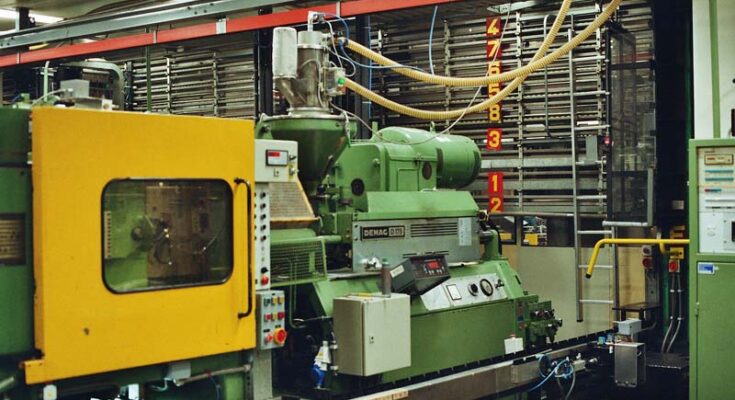Image Credit: flickr.com
The History of Injection Molding: From Its Origins to Modern Techniques
Injection molding has a rich history that dates back to the late 19th century. The process was initially developed as a solution to the demand for more efficient and cost-effective manufacturing methods. The origins of injection molding can be traced back to the invention of the first injection molding machine by John Wesley Hyatt in 1872. This early machine used a plunger mechanism to inject plastic into a mold, creating a solid object.
A Brief Overview of the Origins of Injection Molding
The origins of injection molding can be traced back even further to the use of pressure and heat to shape materials. In the early 19th century, inventors experimented with various methods to mold materials such as metal and rubber. However, it was Hyatt’s invention that revolutionized the manufacturing industry by introducing the concept of injecting molten plastic into a mold under high pressure to create intricate and precise shapes.
Evolving Technologies: How Injection Molding Has Transformed Over Time
Over the years, injection molding technology has evolved significantly, driven by advancements in materials, machinery, and computer-aided design (CAD) software. In the mid-20th century, the development of new thermoplastic resins expanded the range of products that could be manufactured using injection molding. This led to the widespread adoption of injection molding across various industries.
Notable Innovations and Breakthroughs in Injection Molding
Throughout its history, injection molding has seen numerous innovations and breakthroughs. One such breakthrough was the introduction of hot runner systems, which eliminated the need for runners and sprues, reducing waste and improving efficiency. Another significant innovation was the development of multi-shot and multi-material injection molding, allowing for the production of complex parts with different materials and colors.
The Key Components of Injection Molding: Understanding the Process
The injection molding process consists of several key components that work together to create high-quality molded products. Understanding these components is crucial to achieving manufacturing excellence.
The Injection Molding Machine: An In-Depth Look at its Mechanics
The injection molding machine is the heart of the injection molding process. It consists of a hopper, an injection unit, a clamping unit, and a control system. The hopper is where the raw plastic material is stored and fed into the injection unit. The injection unit melts the plastic and injects it into the mold cavity. The clamping unit holds the mold in place and applies the necessary pressure to ensure proper filling of the mold. The control system manages the entire process, including the temperature, pressure, and timing.
Molds and Tooling: The Backbone of Successful Injection Molding
The molds and tooling used in injection molding are crucial for achieving precision and consistency in the final product. Molds are typically made from steel or aluminum and consist of two halves: the core and the cavity. The core forms the interior shape of the product, while the cavity creates the exterior shape. The design and construction of molds require careful consideration of factors such as part complexity, mold material, cooling channels, and ejection mechanisms.
Material Selection: Choosing the Right Resin for Optimum Results
The choice of resin material is critical to the success of an injection molding project. Different resins offer varying properties such as strength, flexibility, heat resistance, and chemical resistance. Factors to consider when selecting a resin include the intended use of the product, desired aesthetics, cost, and environmental impact. It is essential to work closely with material suppliers to ensure the selected resin meets the required specifications.
Mastering Injection Molding: Tips and Techniques for Manufacturing Excellence
Becoming a master of injection molding requires a deep understanding of the process and the application of best practices. Here are some key tips and techniques for achieving manufacturing excellence in injection molding.
Designing for Injection Molding: Best Practices for Effective Moldability
Designing parts that are optimized for injection molding is crucial for achieving high quality and cost-effective production. Key considerations include draft angles, wall thickness, gate location, and the use of ribs and fillets. Collaboration between designers and mold makers is essential to ensure the design is moldable and meets the desired specifications.
Quality Control in Injection Molding: Preventing Defects and Ensuring Consistency
Ensuring consistent quality is a fundamental aspect of injection molding. Quality control measures include rigorous testing and inspection of raw materials, in-process monitoring, and final product inspection. Advanced techniques such as statistical process control (SPC) can help identify and address potential defects early in the production process, preventing costly rework or product recalls.
Optimizing Production Efficiency: Streamlining the Injection Molding Process
Efficiency is a critical factor in injection molding, as it directly impacts production costs and cycle times. Techniques to optimize production efficiency include using automated systems for material handling and mold changeovers, implementing predictive maintenance strategies to minimize machine downtime, and adopting lean manufacturing principles to eliminate waste and improve overall productivity.
The Impact of Injection Molding in Texas: Driving Innovation and Economic Growth
Injection molding plays a significant role in driving innovation and economic growth in the state of Texas. The industry has become an integral part of the Texas manufacturing sector, contributing to job creation and sustainability.
Injection Molding in the Texas Manufacturing Industry: A Closer Look
The injection molding industry in Texas is thriving, with a high concentration of manufacturing facilities and skilled workforce. The state provides a favorable business environment, including access to raw materials, advanced infrastructure, and a robust supply chain. Injection molding companies in Texas cater to various industries, including automotive, electronics, medical, and consumer products.
Job Opportunities in Injection Molding: Fueling the Texas Job Market
The injection molding industry in Texas offers numerous job opportunities across various fields. These include machine operators, mold designers, process engineers, quality control specialists, and maintenance technicians. The industry’s growth has created a positive impact on the Texas job market, providing employment for skilled individuals and contributing to the local economy.
Sustainability and Injection Molding: Promoting Eco-Friendly Practices in Texas
Injection molding in Texas is committed to promoting eco-friendly practices. Companies are implementing sustainable manufacturing processes, including the use of recyclable materials, energy-efficient machinery, and waste reduction strategies. Additionally, efforts are being made to collaborate with local recycling facilities and research institutions to further advance sustainability practices in the industry.
Also Read: How Important is Air Quality in Our Homes




